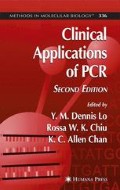Abstract
The polymerase chain reaction (PCR) is an in vitro method for the amplification of DNA. Since the introduction of the PCR in 1985, it has become an indispensable technique for many applications in scientific research and clinical and forensic investigations. In this chapter, the principle and setup of PCR, as well as the methods for analyzing PCR products, will be discussed.
Access this chapter
Tax calculation will be finalised at checkout
Purchases are for personal use only
References
Saiki, R. K., Scharf, S., Faloona, F., et al. (1985) Enzymatic amplification of betaglobin genomic sequences and restriction site analysis for diagnosis of sickle cell anemia. Science 230,1350–1354.
Saiki, R. K., Gelfand, D. H., Stoffel, S., et al. (1988) Primer-directed enzymatic amplification of DNA with a thermostable DNA polymerase.Science 239,487–491.
Nagai, H., Murakami, Y., Morita, Y., Yokoyama, K., and Tamiya, E. (2001) Development of a microchamber array for picoliter PCR.Anal. Chem. 73, 1043–1047.
Puppe, W., Weigl, J. A., Aron, G., et al. (2004) Evaluation of a multiplex reverse ranscriptase PCR ELISA for the detection of nine respiratory tract pathogens. J. Clin. Virol. 30, 165–174.
Tournier, I., Paillerets, B. B., Sobol H., et al. (2004) Significant contribution of germline BRCA2 rearrangements in male breast cancer families. Cancer Res. 64, 8143–8147.
Yap, E. P. and McGee, J. O. (1991) Short PCR product yields improved by lower denaturation temperatures. Nucleic Acids Res. 19, 1713.
Higuchi, R., Krummel, B., and Saiki, R. K. (1988) A general method of in vitro preparation and specific mutagenesis of DNA fragments: study of protein and DNA interactions. Nucleic Acids Res. 16, 7351–7367.
Li, H. H., Gyllensten U. B., Cui X. F., Saiki R. K., Erlich H. A., and Arnheim N. (1988) Amplification and analysis of DNA sequences in single human sperm and diploid cells. Nature 335, 414–417.
Jeffreys, A. J., Kauppi, L., and Neumann, R. (2001) Intensely punctate meiotic recombination in the class II region of the major histocompatibility complex. Nat. Genet. 29, 217–222.
Moutou, C., Gardes, N., and Viville, S. (2004) New tools for preimplantation genetic diagnosis of Huntington’s disease and their clinical applications. Eur. J. Hum. Genet. 12, 1007–1014.
Chou, Q., Russell, M., Birch, D. E., Raymond, J., and Bloch, W. (1992) Prevention of pre-PCR mis-priming and primer dimerization improves low-copy-number amplifications. Nucleic Acids Res. 20, 1717–1723.
Birch, D. E. (1996) Simplified hot start PCR. Nature 381, 445–446.
Eckert, K. A. and Kunkel, T. A. (1991) DNA polymerase fidelity and the polymerase chain reaction. PCR Methods Appl. 1, 17–24.
Cariello, N. F., Swenberg, J. A., and Skopek, T. R. (1991) Fidelity of Thermococcus litoralis DNA polymerase (Vent) in PCR determined by denaturing gradient gel electrophoresis. Nucleic Acids Res. 19, 4193–4198.
Krishnan, M., Ugaz, V. M., and Burns, M. A. (2002) PCR in a Rayleigh-Benard convection cell. Science 298, 793.
Wheeler, E. K., Benett, W., Stratton, P., et al. (2004) Convectively driven polymerase chain reaction thermal cycler. Anal. Chem. 76, 4011–4016.
Braun, D., Goddard, N. L., and Libchaber, A. (2003) Exponential DNA replication by laminar convection. Phys. Rev. Lett. 91, 158103.
Saiki, R. K., Walsh, P. S., Levenson, C. H., and Erlich, H. A. (1989) Genetic analysis of amplified DNA with immobilized sequence-specific oligonucleotide probes. Proc. Natl. Acad. Sci. USA 86, 6230–6234.
Dhami, P., Coffey, A. J., Abbs, S., et al. (2005) Exon array CGH: detection of copy-number changes at the resolution of individual exons in the human genome. Am. J. Hum. Genet. 76, 750–762.
Devries, S., Nyante, S., Korkola, J., et al. (2005) Array-based comparative genomic hybridization from formalin-fixed, paraffin-embedded breast tumors. J. Mol. Diagn. 7, 65–71.
Hu, D. G., Webb, G., and Hussey, N. (2004) Aneuploidy detection in single cells using DNA array-based comparative genomic hybridization. Mol. Hum. Reprod. 10, 283–289.
Heid, C. A., Stevens, J., Livak, K. J., and Williams, P. M. (1996) Real time quantitative PCR. Genome Res. 6, 986–994.
Nelson, M. R., Marnellos, G., Kammerer, S., et al. (2004) Large-scale validation of single nucleotide polymorphisms in gene regions. Genome Res. 14, 1664–1668.
Buetow, K. H., Edmonson, M., MacDonald, R., et al. (2001) High-throughput development and characterization of a genomewide collection of gene-based single nucleotide polymorphism markers by chip-based matrix-assisted laser desorption/ ionization time-of-flight mass spectrometry. Proc. Natl. Acad. Sci. USA 98, 581–584.
Mohlke, K. L., Erdos, M. R., Scott, L. J., et al. (2002) High-throughput screening for evidence of association by using mass spectrometry genotyping on DNA pools. Proc. Natl. Acad. Sci. USA 99, 16,928–16,933.
Lleonart, M. E., Ramon y Cajal, S., Groopman, J. D., and Friesen, M. D. (2004) Sensitive and specific detection of K-ras mutations in colon tumors by short oligonucleotide mass analysis. Nucleic Acids Res. 32, e53.
Ding, C., Chiu, R. W. K., Lau, T. K., et al. (2004) MS analysis of single-nucleotide differences in circulating nucleic acids: Application to noninvasive prenatal diagnosis. Proc. Natl. Acad. Sci. USA 101, 10,762–10,767.
Editor information
Editors and Affiliations
Rights and permissions
Copyright information
© 2006 Humana Press Inc.
About this protocol
Cite this protocol
Lo, Y.M.D., Chan, K.C.A. (2006). Introduction to the Polymerase Chain Reaction. In: Lo, Y.M.D., Chiu, R.W.K., Chan, K.C.A. (eds) Clinical Applications of PCR. Methods in Molecular Biology™, vol 336. Humana Press. https://doi.org/10.1385/1-59745-074-X:1
Download citation
DOI: https://doi.org/10.1385/1-59745-074-X:1
Publisher Name: Humana Press
Print ISBN: 978-1-58829-348-0
Online ISBN: 978-1-59745-074-4
eBook Packages: Springer Protocols

